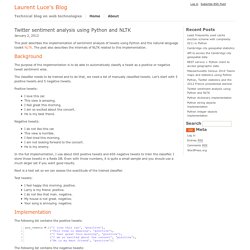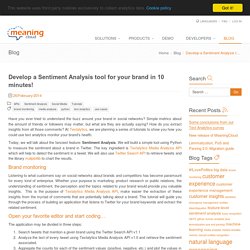

Twitter sentiment analysis using Python and NLTK. This post describes the implementation of sentiment analysis of tweets using Python and the natural language toolkit NLTK.

The post also describes the internals of NLTK related to this implementation. Background The purpose of the implementation is to be able to automatically classify a tweet as a positive or negative tweet sentiment wise. The classifier needs to be trained and to do that, we need a list of manually classified tweets. Let’s start with 5 positive tweets and 5 negative tweets. Positive tweets: I love this car.This view is amazing.I feel great this morning.I am so excited about the concert.He is my best friend. Negative tweets: I do not like this car.This view is horrible.I feel tired this morning.I am not looking forward to the concert.He is my enemy. In the full implementation, I use about 600 positive tweets and 600 negative tweets to train the classifier.
Next is a test set so we can assess the exactitude of the trained classifier. Test tweets: Implementation Classifier Classify. Basic Sentiment Analysis with Python. 01 nov 2012 [Update]: you can check out the code on Github In this post I will try to give a very introductory view of some techniques that could be useful when you want to perform a basic analysis of opinions written in english.

These techniques come 100% from experience in real-life projects. Don't expect a theoretical introduction of Sentiment Analysis and the multiple strategies out there to achieve opinion mining, this is only a practical example of applying some basic rules to extract the polarity (positive or negative) of a text. Let's start looking at an example opinion: "What can I say about this place. As you can see, this is a mainly negative review about a restaurant. General or detailed sentiment Sometimes we only want an overall rating of the sentiment of the whole review. A Fast and Powerful Scraping and Web Crawling Framework.
Text Analysis 101: Document Classification. Document classification is an example of Machine Learning (ML) in the form of Natural Language Processing (NLP).

By classifying text, we are aiming to assign one or more classes or categories to a document, making it easier to manage and sort. By Parsa Ghaffari. Introduction Document classification is an example of Machine Learning (ML) in the form of Natural Language Processing (NLP). By classifying text, we are aiming to assign one or more classes or categories to a document, making it easier to manage and sort. This is especially useful for publishers, news sites, blogs or anyone who deals with a lot of content. Broadly speaking, there are two classes of ML techniques: supervised and unsupervised. Depending on the classification algorithm or strategy used, the classifier might also provide a confidence measure to indicate how confident it is that the classification label is correct.
(some,tigers,live,in,the,zoo,green,is,a,color,go,to,new,york,city) class. Book. Natural Language Processing with Python – Analyzing Text with the Natural Language Toolkit Steven Bird, Ewan Klein, and Edward Loper This version of the NLTK book is updated for Python 3 and NLTK 3.

The first edition of the book, published by O'Reilly, is available at (There are currently no plans for a second edition of the book.) Develop Sentiment Analysis tool for your brand in 10 min - Textalytics. Have you ever tried to understand the buzz around your brand in social networks?

Simple metrics about the amount of friends or followers may matter, but what are they are actually saying? How do you extract insights from all those comments? At Textalytics, we are planning a series of tutorials to show you how you could use text analytics monitor your brand’s health. Today, we will talk about the fanciest feature: Sentiment Analysis. We will build a simple tool using Python to measure the sentiment about a brand in Twitter.
Brand monitoring Listening to what customers say on social networks about brands and competitors has become paramount for every kind of enterprise. Open your favorite editor and start coding… The application may be divided in three steps: Create a Twitter application First of all, you need to create a Twitter application as a developer. Get a sample of tweets using Twitter Search API and TwitterAPI library. Next step is the search of the tweets that mention your brand. Basic Sentiment Analysis with Python. Wiki-network/pywc.py at master · volpino/wiki-network. Twitter sentiment analysis using Python and NLTK.